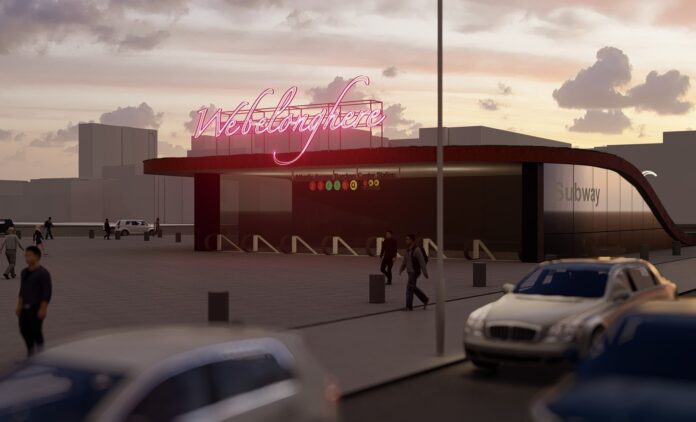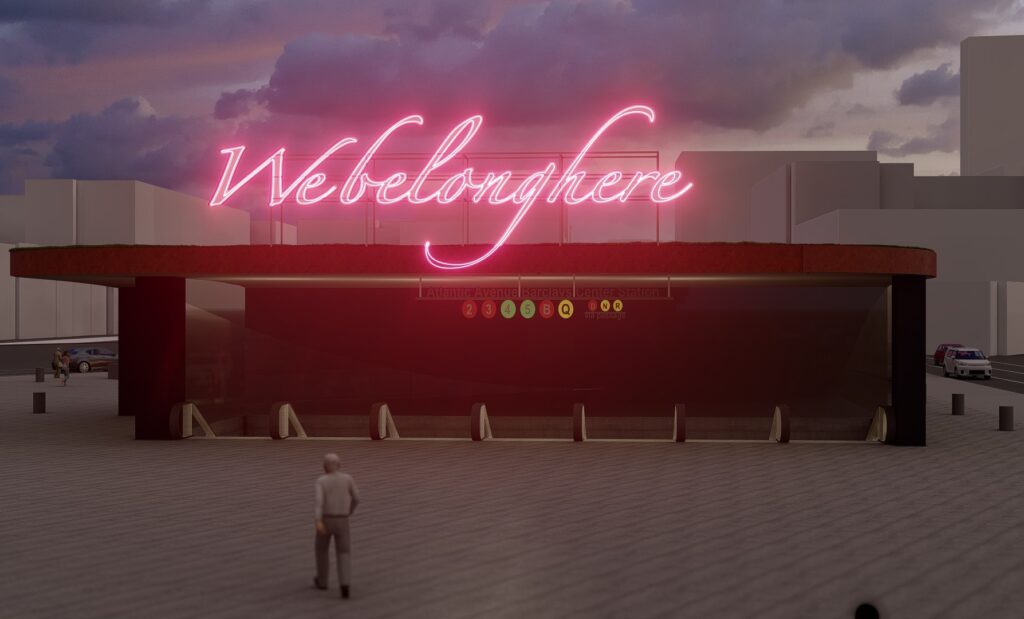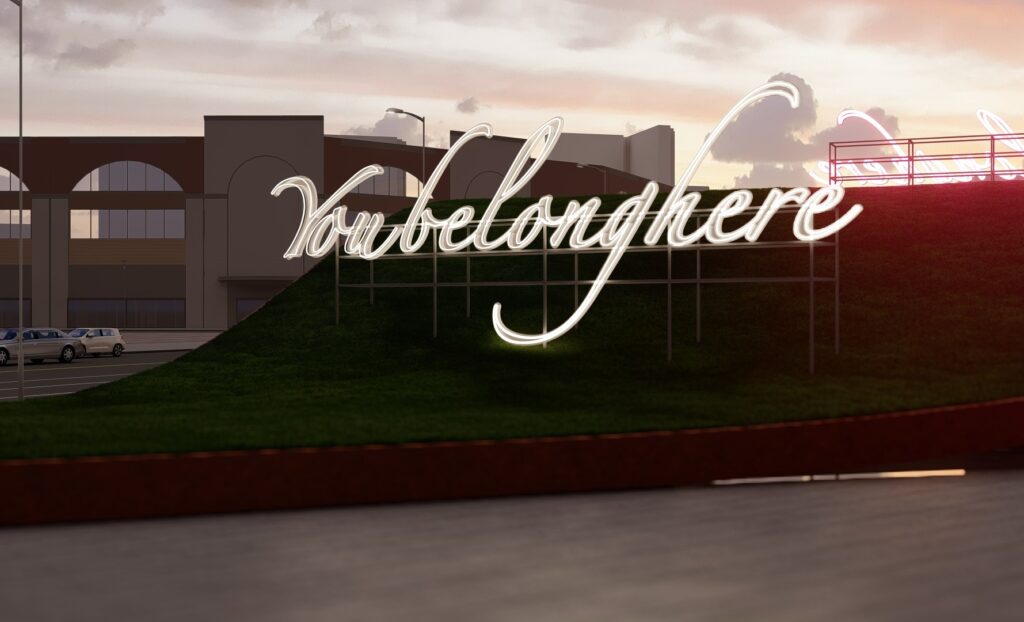
The illuminated artwork designed by Tavares Strachan for the front of the Barclays Center reflects the changes that the borough has undergone since the arena opened a decade ago.
The text isn’t complicated, but the message thrums with meaning. Two neon signs, one pink and one white, are going up at the intersection of Atlantic and Flatbush Avenues in Brooklyn, on the plaza outside the Barclays Center sports arena. “We belong here,” one declares. Its twin narrows the scope: “You belong here.”
An illumination designed by the artist Tavares Strachan, You Belong Here/We Belong Here might read like an expression of solidarity directed to the protesters who frequently gathered in Barclays Center plaza following the death of George Floyd in 2020. But it could also sound like a pointed rebuke to a different crowd: Years back, this site was the target of demonstrations against the construction of the Atlantic Yards development, which the arena anchors. In 2006, at least 2,000 people, including Brooklyn residents and actors Steve Buscemi and Rosie Perez, assembled to speak out against the housing displacement that this project threatened to bring.
Since its opening in 2012, the Barclays Center has gone from being the centerpiece in a community-wide debate about gentrification to a widely adopted public square for people fighting for social justice. That makes Strachan’s artwork a site-specific installation for a site whose meaning has shifted powerfully over the last decade.
“I’ve always been interested in the ideas of belonging. That really resonates with me,” says Clara Wu Tsai, co-owner of the company that operates the Barclays Center and of the pro basketball teams that play there, the Brooklyn Nets and New York Liberty, and cofounder of the Joe and Clara Tsai Foundation, which paid for the artwork. “Even before George Floyd, I thought it was the perfect statement to put there, in the heart of Brooklyn.”

The roughly 45-by-18-feet signs will be installed over the shed to the Atlantic Avenue subway station, which is framed in the same rusted weathering steel as the SHoP Architects–designed arena. Just across the plaza from the Barclays Center’s oculus, people entering the subway station will see one message straight on, rendered in colossal pink neon letters over the entrance (“We belong here”). The other sign, in white neon, will be installed over the grass-covered backside of the subway shed (“You belong here”). The piece will open to the public on Oct. 23.
Strachan, a Bahamian-born artist based in New York and known for his wide-ranging research-based projects, first introduced this pink neon script on a barge in 2014, when he floated the installation down the Mississippi River for the Prospect New Orleans art festival. He says that the font is a hybrid of his own handwriting and a calligraphy style he learned in high school (“as a side hustle”). Writing is a way to harness authority, he says, and as a child, practicing cursive, learning its cadence, meant wrestling with knowledge itself. Growing up listening to hip-hop and reggae, he realized that as you sing along to the lyrics, you becomes the personification of the words.
“With this piece, as you read it, you say it,” Strachan says. “It’s an affirmation, a call to action.”
Strachan and Wu Tsai first started talking about a collaboration three years ago, before the protests that rocked New York and other cities in the wake of Floyd’s death. The idea became more urgent after the crowds that filled the plaza to chant against police violence late in May 2020 solidified into an almost perpetual state of demonstrations for different causes in June. The public art installation would be just a step behind the times: Brooklyn has already transformed the plaza into a public commons and a stage for political expression.
Wu Tsai is pairing the piece’s message of inclusion with a philanthropic commitment. Back in June, the Joe and Clara Tsai Foundation launched a three-year, $2.5 million campaign to expand local access to capital called Brooklyn EXCELerate. In partnership with two community development financial institutions, Brooklyn Alliance Capital and TruFund Financial, the initiative will provide capital for recovery and other needs to Black, Indigenous and people-of-color business owners in Brooklyn. It’s part of a broader Social Justice Fund, launched in August 2020, set to spend $50 million over 10 years on economic mobility and racial justice.
Over its first three months, the program has approved 25 loans totaling $560,000, with most going to Black-owned businesses and women. Largely, these are younger businesses in the service or hospitality sectors that saw revenues fall due to the pandemic. “A lot of businesses can’t get loans because they have lower credit scores,” Wu Tsai says. “We wanted to launch this program to give character-based loans rather than loans based on credit history, which can be deeply discriminatory. A lot of BIPOC entrepreneurs bootstrapped themselves, with lots of loans or high credit card debt.”

The idea is for the Barclays Center, or at least its owners’ philanthropic division, to help support dozens of Brooklyn business owners who can’t access capital in order to keep them in place. That suggestion would have floored Brooklynites who battled, unsuccessfully, to block the Atlantic Yards development from proceeding.
Rebranded as Pacific Park Brooklyn in 2014, the megaproject has been slow going. In 2016, owners of shops near the development complained that the promised boost to business had yet to materialize. Four of 16 planned towers are now complete, and four more are under construction. When it’s finished, the decked-over railway-yard development will deliver 1,930 condos and 4,500 apartments, including subsidized units, plus 247,000 square feet of retail. The 2,250 affordable rental units are due by 2025, according to Norman Oder, the watchdog journalist who has been tracking Atlantic Yards/Pacific Park for more than 15 years. Those numbers are nothing to sneeze at: Affordable units coming to the site add up to more than all of the units for the top five largest affordable developments under construction in New York right now. But delays are a vexing issue. “The jobs and affordable housing — especially for lower-income households — are way behind projections,” Oder writes.
























